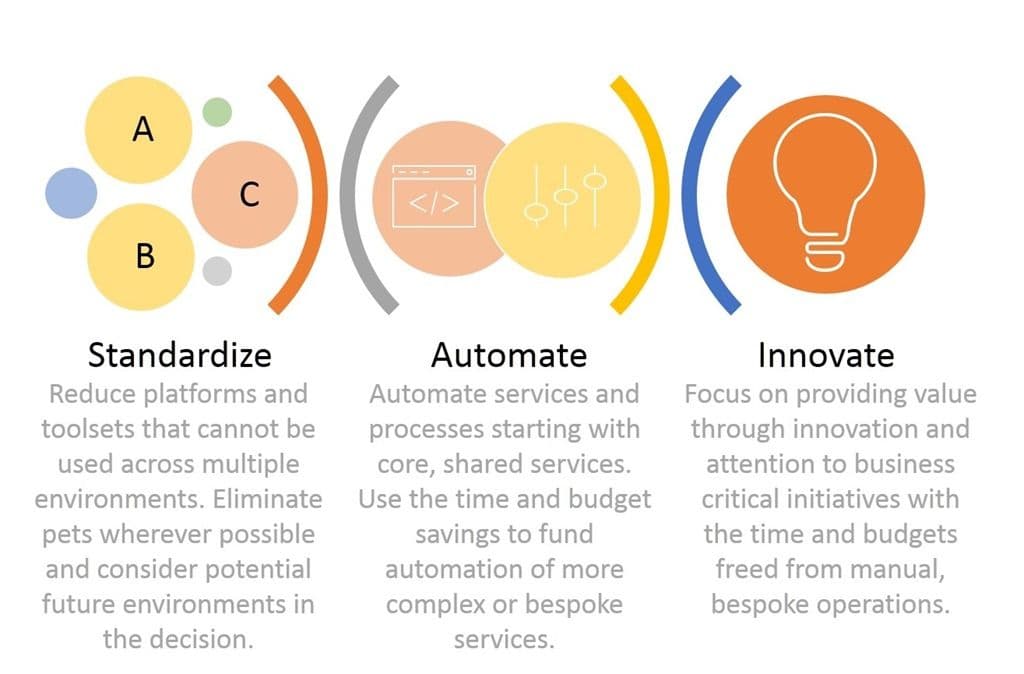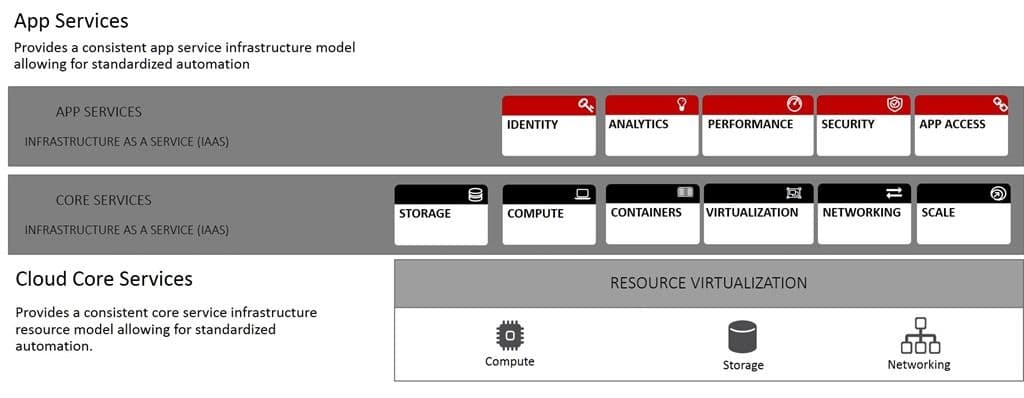Cloud has always been about realizing economies of scale. With digital transformation driving organizations to seek new opportunities to improve productivity (internal) and profit (external) with applications, the rate at which operations and apps must scale has increased exponentially. The number of apps and frequency with which they are updated and enhanced has become unmanageable through traditional manual methods. Scaling apps and operations has hit a human bottleneck. We simply can’t throw more people at the problem and expect the same outcomes anymore. The cost per application – per user, per customer, per transaction – increase far faster than the revenues and cost savings achieve. That imbalance makes it impractical to continue delivering applications the way we have in the past.
Cloud has always promised to change that equation by introducing the power of standardization. This isn’t just about filling racks with exact copies of the same white-box servers, it’s about the standardization of operations. Public cloud achieves that by providing a standardized platform through which operations can interface with resources. By standardizing the provisioning and management of those common, core resources (services) – compute, network, and storage - automation (that’s DevOps) can be applied, and a higher economy of scale achieved.
But applications need more than just common, core services. They need to be faster and safer, and that means getting smarter about how to deliver the sometimes bespoke services apps need like security and performance.

Standardize then Automate to Innovate
Apps might share common security and performance needs, but common is not always enough to protect and propel the apps consumers demand today. They need standard security plus protection against platform and protocol level attacks. They need positive performance improvements that add value in the form of time saved spent entering passwords and producing reports.
But you won’t have time for those bespoke bells and whistles or custom configurations if you haven’t standardized first. That’s cloud – whether on-premises or off. Cloud is the first step toward enabling the attention required to grab hold of competitive advantage and delight consumers with fast, secure apps with which to engage with your business.
Still, not every app is a fit for just any cloud environment. Some require the comfort and security of a corporate environment. Others can only thrive if they’re out in the public arena, in a public cloud. This is one of the reasons we’re seeing the rise of multi-cloud strategies and implementations, and new environments (like colocation and interconnects) that help realize them. Because just as we’ve always operated on the premise “right tool for the job”, today the digital equivalent is “right cloud for the job.”
Employing a multi-cloud strategy makes standardization more challenging. Each environment may be standardized itself, but not with each other. Tools and frameworks help address that challenge by providing a layer of “standard interface” to the operators charged with managing off-premises deployments. It’s an operational tier that enables standardization in a world where clouds are as different as snowflakes.
Once you’ve standardized the common, core services necessary to achieve the economies of scale you’re striving for you need to consider the app services that provide security plus protection and the positive performance required to keep consumers engaged. It has been noted that system attacks are the fastest-growing cause of data center outages, rising from 2 percent in 2010 to 22 percent of outages. And while direct attacks on an app in the cloud might not take out the data center any more, taking out an app closely tied to your brand can be devastating to your reputation and your bottom line.
The same strategy is required here, too. You need to employ a platform that offers a standard “operational interface” to the operators and architects responsible for creating, deploying, and managing those app services. That standard interface provides the same kind of operational tier for app services as the tools and frameworks you use for the common core services.

Once you’ve standardized, and you’ve got your shared operational interface, you can automate. You’ll win big if you automate common, shared services and processes first, and then use the time and budget savings from the effort to fund more advanced and potentially bespoke services and processes. Here, the common operational interface – the operations tier – pays off by encouraging reuse of scripts and code as well as taking advantage of existing skills to achieve the level of automation necessary to realize parity with developers who commit code multiple times a day and expect deploys more frequently.
Automation is the secret sauce to improving the economies of scale and reducing variation in results (which is really Six Sigma/Lean talk for “eliminating defects and errors in processes”). We know from studies that about 22% of outages are the result of human error. And we know from other studies that IT spends about 15.9% of its time on troubleshooting and remediation, some of which are likely a direct result of those human errors. Automation can free up time not just by reducing the significant percentage of IT’s focus on provisioning, updates, patching, and configuration management, but by reducing the number of errors and time spent finding – and fixing – them.
Finally, you’ve freed up enough time and budget to concentrate on innovation. Whether that’s participating more aggressively in business-related ideation sessions or seeking out new opportunities to optimize IT, it’s all innovation. And it’s all made possible by automation, which only truly excels when applied to a standardized system.
This is nothing new; assembly lines and automation have been providing much needed economies of scale for over a century now. And they all start with the same steps of standardizing then automating in order to innovate with the time and cost savings achieved. There are plenty of techniques and masters of the black arts of optimizing that automation to realize even greater benefits, but before you get there you must standardize first.
For IT that means looking at the tools, frameworks, and platforms you rely on across all properties – off-prem and on, cloud and traditional – and standardizing so you can begin automating to innovate.
About the Author

Related Blog Posts

Nutanix and F5 expand successful partnership to Kubernetes
Nutanix and F5 have a shared vision of simplifying IT management. The two are joining forces for a Kubernetes service that is backed by F5 NGINX Plus.

AppViewX + F5: Automating and orchestrating app delivery
As an F5 ADSP Select partner, AppViewX works with F5 to deliver a centralized orchestration solution to manage app services across distributed environments.

Build a quantum-safe backbone for AI with F5 and NetApp
By deploying F5 and NetApp solutions, enterprises can meet the demands of AI workloads, while preparing for a quantum future.

F5 ADSP Partner Program streamlines adoption of F5 platform
The new F5 ADSP Partner Program creates a dynamic ecosystem that drives growth and success for our partners and customers.
F5 NGINX Gateway Fabric is a certified solution for Red Hat OpenShift
F5 collaborates with Red Hat to deliver a solution that combines the high-performance app delivery of F5 NGINX with Red Hat OpenShift’s enterprise Kubernetes capabilities.
Phishing Attacks Soar 220% During COVID-19 Peak as Cybercriminal Opportunism Intensifies
David Warburton, author of the F5 Labs 2020 Phishing and Fraud Report, describes how fraudsters are adapting to the pandemic and maps out the trends ahead in this video, with summary comments.
